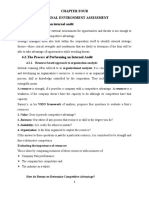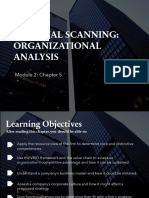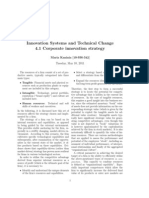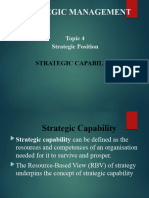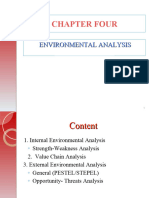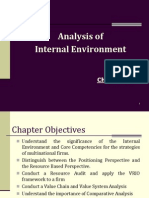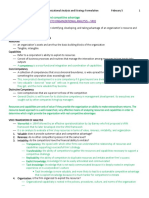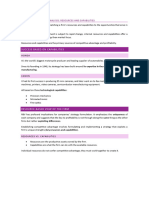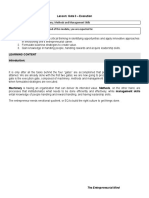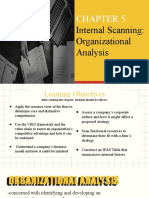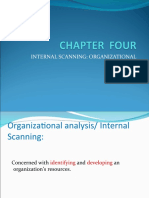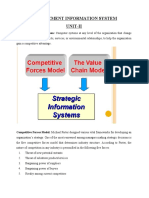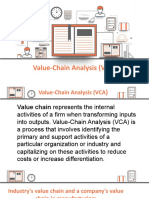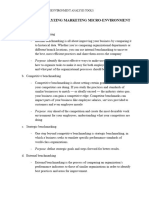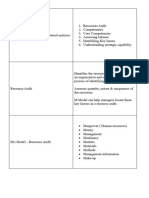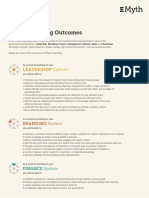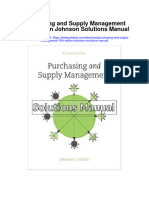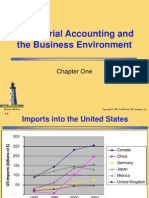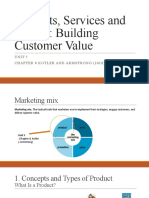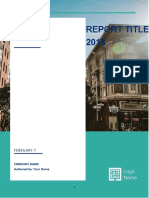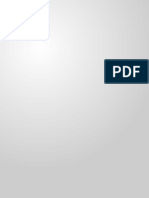0 ratings0% found this document useful (0 votes)
10 viewsChapter 4
Chapter 4
Uploaded by
erleen sumileThis document discusses resources and capabilities that organizations possess and how they add value. It covers two strategic routes for adding value: 1) raising the value of outputs through higher sales or prices and 2) lowering input costs through investments. The value chain and value system identify where value is added through primary activities like logistics, operations, marketing, and support activities like procurement and technology. Competitive advantage comes from resources that are valuable, rare, difficult to imitate, and supported by an organization's capabilities. Differentiation, low costs, niche marketing, technology, quality, and other factors can provide sustainable competitive advantages.
Copyright:
© All Rights Reserved
Available Formats
Download as DOCX, PDF, TXT or read online from Scribd
Chapter 4
Chapter 4
Uploaded by
erleen sumile0 ratings0% found this document useful (0 votes)
10 views5 pagesThis document discusses resources and capabilities that organizations possess and how they add value. It covers two strategic routes for adding value: 1) raising the value of outputs through higher sales or prices and 2) lowering input costs through investments. The value chain and value system identify where value is added through primary activities like logistics, operations, marketing, and support activities like procurement and technology. Competitive advantage comes from resources that are valuable, rare, difficult to imitate, and supported by an organization's capabilities. Differentiation, low costs, niche marketing, technology, quality, and other factors can provide sustainable competitive advantages.
Original Description:
STRATEGIC MANAGEMENT CHAPTER 4 SUMMARY
Original Title
CHAPTER 4
Copyright
© © All Rights Reserved
Available Formats
DOCX, PDF, TXT or read online from Scribd
Share this document
Did you find this document useful?
Is this content inappropriate?
This document discusses resources and capabilities that organizations possess and how they add value. It covers two strategic routes for adding value: 1) raising the value of outputs through higher sales or prices and 2) lowering input costs through investments. The value chain and value system identify where value is added through primary activities like logistics, operations, marketing, and support activities like procurement and technology. Competitive advantage comes from resources that are valuable, rare, difficult to imitate, and supported by an organization's capabilities. Differentiation, low costs, niche marketing, technology, quality, and other factors can provide sustainable competitive advantages.
Copyright:
© All Rights Reserved
Available Formats
Download as DOCX, PDF, TXT or read online from Scribd
Download as docx, pdf, or txt
0 ratings0% found this document useful (0 votes)
10 views5 pagesChapter 4
Chapter 4
Uploaded by
erleen sumileThis document discusses resources and capabilities that organizations possess and how they add value. It covers two strategic routes for adding value: 1) raising the value of outputs through higher sales or prices and 2) lowering input costs through investments. The value chain and value system identify where value is added through primary activities like logistics, operations, marketing, and support activities like procurement and technology. Competitive advantage comes from resources that are valuable, rare, difficult to imitate, and supported by an organization's capabilities. Differentiation, low costs, niche marketing, technology, quality, and other factors can provide sustainable competitive advantages.
Copyright:
© All Rights Reserved
Available Formats
Download as DOCX, PDF, TXT or read online from Scribd
Download as docx, pdf, or txt
You are on page 1of 5
MNGT – ED32 (STRATEGIC MANAGEMENT) WHY DOES AN ORGANISATION POSSESS ANY
RESOURCES AT ALL? THE MAKE-OR-BUY
DECISION
CHAPTER 4 Outsourcing - using a group of local
suppliers.
“Analysing Resources and Capabilities” Franchising - operated under the control of
Benetton but owned by others outside the
company.
Value-added route explores how the
organisation takes goods from its suppliers
and turns them into finished goods and RESOURCE ANALYSIS AND ADDING VALUE
services that are then sold to its customers:
essentially, adding value to the inputs from its Added value - can be defined as the
suppliers is fundamental to the role of every difference between the market value of the
organisation. output of an organisation and the cost of
Competitive advantage route attempts to its inputs.
find the special resources that enable the Two strategic routes:
organisation to compete how and why some
resources deliver sustainable competitive Raising the value of outputs - may mean
advantage is crucial to strategy development. raising the level of sales, either by raising the
volume of sales or by raising the unit price.
Lowering the costs of inputs - may require
ANALYSING RESOURCES AND CAPABILITIES investment – for example, in new machinery
to replace workers – at the same time as
The resources of an organisation - are those seeking the cost reduction.
assets that deliver value added in the
organisation. The capabilities of an organisation
are those management skills, routines, and
ADDING VALUE: THE VALUE CHAIN AND THE
leadership that deploy, share, and generate value
VALUE SYSTEM – THE CONTRIBUTION OF
from the resources of the organisation.
PORTER
The value chain - identifies where the
As a starting point, it is useful to divide resources into value is added in an organisation and links
three broad categories: the process with the main functional parts
of the organisation.
1. Tangible resources - are the physical
resources of the organisation that The value system - shows the wider routes
contribute to its value added. in an industry that add value to incoming
2. Intangible resources - are those resources supplies and outgoing distributors and
that have no physical presence but customers. It links the industry value
represent a real benefit to the chain to that of other industries.
organisation, like brand names, service
levels, and technology.
3. Organisational capabilities - are the skills,
routines, management, and leadership of
the organisation.
According to Porter, the primary activities of the RESOURCE ANALYSIS AND COMPETITIVE
company are: ADVANTAGE – THE RESOURCE-BASED VIEW
(RBV)
Inbound logistics. These are the areas
concerned with receiving the goods from The RBV (resource-based view) - stresses
suppliers, storing them until required by the importance of the individual resources
operations and handling and transporting of the organisation in delivering the
them within the company. competitive advantage and value-added of
Operations. This is the production area of the the organisation.
company. In some companies, this might be Sustainable competitive advantage - is an
split into further departments. advantage over competitors that cannot
Outbound logistics. These distribute the final easily be imitated.
product to the customer. They would clearly
include transport and warehousing but might Examine competitors (the organisation itself and its
also include selecting and wrapping resources):
combinations of products in a multiproduct 1. Differentiation. This is the development of
company. unique features or attributes in a product or
Marketing and sales. This function analyses service that position it to appeal especially to
customers’ wants and needs and brings to the a part of the total market. Branding is an
attention of customers the products or example of this source.
services the company has for sale. Advertising 2. Low costs. The development of low-cost
and promotions fall within this area. production enables the firm to compete
Service. Before or after a product or service against other companies either on the basis of
has been sold, there is often a need for pre- lower prices or possibly on the basis of the
installation or after-sales service. There may same prices as its competitors but with more
also be a requirement for training, answering services being added.
customer queries, etc. 3. Niche marketing. A company may select a
small market segment and concentrate all its
The support activities are:
efforts on achieving advantages in this
1. Procurement - responsible for purchasing segment. Such a niche will need to be
goods and materials that are then used in the distinguished by special buyer needs.
operations of the company. 4. High performance or technology. Special
2. Technology development - this may be an levels of performance or service can be
important area for new products in the developed that simply cannot be matched by
company. It will cover the existing technology, other companies – for example, through
training, and knowledge that will allow a patented products or recruitment of
company to remain efficient. especially talented individuals.
3. Human resource management - 5. Quality. Some companies off er a level of
Recruitment, training, management quality that others are unable to match.
development, and the reward structures are 6. Service. Some companies have deliberately
vital elements in all companies. sought to provide superior levels of service
4. Firm infrastructure - This includes the that others have been unable or unwilling to
background planning and control systems – match.
for example, accounting, etc. – that allow 7. Vertical integration. The backward
companies to administer and direct their acquisition of raw material suppliers and/or
development. It includes company the forward purchase of distributors may
headquarters. provide advantages that others cannot match.
8. Synergy. This is the combination of parts of a
business such that the sum of them is worth
more than the individual parts – that is, 2 + 2
= 5.
9. Culture, leadership, and style of an
organisation. The way that an organisation
leads, trains, and supports its members may - this is a sequential decision-making
be a source of advantage that others cannot approach which starts by questioning
match. It will lead to innovative products, each resource and asking if it is valuable.
exceptional levels of service, fast responses to 1. Valuable
new market developments and so on. 2. Rare
3. Cannot be imitated
4. Organising capability
The seven elements of resource-based
sustainable competitive advantage:
The resource-based view (RBV) - argues that the
Prior or acquired resources individual resources of an organisation provide a
path dependency - building on stronger basis for strategy development than
existing strengths will exploit any real industry analysis.
uniqueness that has been built as a
result of the organisation’s history Sustainable competitive advantage (SCA) - is an
and investment over many years. advantage over competitors that cannot easily be
Innovative capability imitated.
Being truly competitive
Substitutability
Appropriability NOTE: There are seven elements of resource-based
Durability competitive advantage: prior or acquired resources,
Imitability innovative ability, being truly competitive,
Tangible uniqueness - Some form of substitutability, appropriability, durability, and
specific differentiation, such as imitability.
branding or a specific geographic
location, or patent protection, will
delay imitability. The VRIO Framework – Valuable, Rare, Inimitable,
Causal ambiguity - It may not be and Organisationally possible – can be used to test
obvious to competitors what gives a resources for their ability to contribute to
resource its competitive edge. There competitive advantage.
may be some complex organisational
processes that have taken years to
develop that are difficult for outside IDENTIFYING WHICH RESOURCES AND
companies to learn or acquire. CAPABILITIES DELIVER SUSTAINABLE
Investment deterrence - When the COMPETITIVE ADVANTAGE
market has limited or unknown
growth prospects and it is difficult to Basic resource analysis:
make a small initial investment, a 1. Tangible resources: the physical resources of
substantial investment by the the organisation.
organisation in the new strategy may
2. Intangible resources: the many other
well deter competitors from entering
resources that are important but are not
the market.
physically present.
3. Organisational capability: the skills,
structures and leadership of the organisation
that bind all its assets together and allow
them to interact efficiently.
VRIO Framework – a mechanism for testing
competitive resources. Three distinctive capabilities:
Architecture - is the network of • bespoke solutions
relationships and contracts both inside
RESOURCE AND CAPABILITY ANALYSIS –
and outside the firm.
IMPROVING COMPETITIVE ADVANTAGE
Reputation - is the strategic standing of the
organisation in the eyes of its customers Three elements:
and other stakeholders.
Innovative capability - is the special talent 1. benchmarking – the comparison of
possessed by some organisations for practice with that of other organisations in
developing and exploiting innovative order to identify areas for improvement.
ideas. 2. leveraging resources - in any organisation,
it is essential to exploit its existing
resources to the full.
Core competencies - are a group of Existing resources can be exploited in five areas:
production skills and technologies that
enable an organisation to provide a Concentration – focusing resources on the
particular benefit to customers; they key objectives of the organisation and
underpin the leadership that companies targeting, in particular, those that will have
have built or wish to acquire over their the largest influence on value added.
competitors. Conservation – using every part of the
resource, perhaps recycling where possible,
Three areas that distinguish the major core with the aim of exploiting every aspect
competencies: available to the organisation.
Accumulation – digging deep into the
1. Customer value. Competencies must make a resources of the organisation to discover
real impact on how the customer perceives every scrap of accumulated knowledge and
the organisation and its products or services. skill, coupled with the acquisition of outside
2. Competitor differentiation. This must be skills and experience, where appropriate.
competitively unique. If the whole industry Complementarity – analysing resources from
has the skill, then it is not core unless the the perspective of blending new elements
organisation’s skills in the area are really together, such as marketing and operations,
special. and supporting stronger elements so that
3. Extendable. Core skills need to be capable of they do not suffer from weaknesses
providing the basis of products or services elsewhere in the organisation.
that go beyond those currently available. The Recovery – ensuring that resources generate
skill needs to be removed from the particular cash quickly where possible, thus achieving
product group in which it currently rests. the full benefit of new and existing resources
sooner rather than later.
By knowledge - is meant the accumulation 3. Upgrading resources - involved with
over time of the skills, routines and commodity products where there is little
capabilities that shape the organisation’s differentiation between products beyond the
ability to survive and compete in markets. price.
Resource-based view and SMEs
SMEs often develop strategies that might include:
• higher levels of personal service
• specialist expertise
• design skills
• regional knowledge
ANALYSING OTHER IMPORTANT COMPANY Culture analysis needs to be tested for strategic
RESOURCES: ESPECIALLY HUMAN RESOURCES relevance in at least the following five areas:
Three approaches: Risk
Rewards
Financial perspective - including cash fl ow,
shareholding, tax, and related issues. Change
Operations (production) perspective - Cost reduction
involving such matters as lean production, Competitive advantageRAGE
inventory control and quality manufacturing
and services.
Human resources perspective - examining
topics such as organisational culture,
leadership and change.
Organisational Culture - is the set of
beliefs, values and learned ways of
managing of an organisation.
The cultural web - consists of the factors
that can be used to characterise some
aspects of the culture of an organisation.
Developing the cultural web:
1. Stories
2. Routines
3. Rituals
4. Symbols
5. Control systems
6. Organisational structure
7. Power structures
Shaping the future cultural style of the organisation
1. The power culture - organisation revolves
around and is dominated by one individual or
a small group.
2. The role culture - organisation relies on
committees, structures, logic and analysis.
3. The task culture - The organisation is geared
to tackling identified projects or tasks.
4. The personal culture - individual works and
exists purely for him/herself. The
organisation is tolerated as the way to
structure and order the environment for
certain useful purposes, but the prime area of
interest is the individual.
You might also like
- Internal Analysis: Resources, Capabilities, and Core CompetenciesDocument8 pagesInternal Analysis: Resources, Capabilities, and Core CompetenciesNadine100% (1)
- Internal ScanningDocument4 pagesInternal Scanningfikha zahirahNo ratings yet
- Sedex Supplier WorkbookDocument388 pagesSedex Supplier WorkbookShafiqulHasan100% (2)
- 4.1. The Nature of An Internal Audit: Chapter Four Internal Environment AssessmentDocument10 pages4.1. The Nature of An Internal Audit: Chapter Four Internal Environment AssessmentwubeNo ratings yet
- Topic 4 Internal Environment 1Document7 pagesTopic 4 Internal Environment 1moza salimNo ratings yet
- NOTES - Operation and Supply Chain ManagementDocument6 pagesNOTES - Operation and Supply Chain ManagementKarel Shane KamensaNo ratings yet
- Module 2 Chapter 5 INTERNAL SCANNING ORGANIZATIONAL ANALYSISDocument28 pagesModule 2 Chapter 5 INTERNAL SCANNING ORGANIZATIONAL ANALYSISRenella Mary MapaNo ratings yet
- Corporate Innovation StrategyDocument2 pagesCorporate Innovation StrategyMaria KaniniaNo ratings yet
- Topic 4 Strategic Position-Strategic CapabilityDocument28 pagesTopic 4 Strategic Position-Strategic CapabilityDumisani NyirendaNo ratings yet
- Internal Scanning: Organizational AnalysisDocument16 pagesInternal Scanning: Organizational AnalysisÜ John Anderson100% (1)
- Chapter 4Document46 pagesChapter 4asterayemetsihet87No ratings yet
- BPSMDocument36 pagesBPSMritesh palitNo ratings yet
- Finals Reviwer For EntrepDocument3 pagesFinals Reviwer For EntrepMhaica GalagataNo ratings yet
- OMTQM Final HandoutsDocument5 pagesOMTQM Final HandoutsSherwin AuzaNo ratings yet
- Analysis of Internal Environment: Chapter-5Document34 pagesAnalysis of Internal Environment: Chapter-5Farhan Israq AhmedNo ratings yet
- Lesson 5 Organizational Analysis and Competitive Advantage PDFDocument47 pagesLesson 5 Organizational Analysis and Competitive Advantage PDFLadybellereyann A TeguihanonNo ratings yet
- Resource Based Viw of The FirmDocument14 pagesResource Based Viw of The FirmOtieno AlooNo ratings yet
- Lesson 3 - Internal Analysis IIDocument35 pagesLesson 3 - Internal Analysis IIsurangauorNo ratings yet
- February 5 - CH 5 & 6 MGMT 4000Document10 pagesFebruary 5 - CH 5 & 6 MGMT 4000Raquel VandermeulenNo ratings yet
- S & EPM Unit 2Document30 pagesS & EPM Unit 2SaikatPatraNo ratings yet
- Internal Scanning: Organizational Analysis: Session 3Document40 pagesInternal Scanning: Organizational Analysis: Session 3YOLAPOHANNo ratings yet
- Program Doktor Ilmu Akuntansi Universitas Airlangga: Corporate Strategy: A Resource Based Approach (Summary Chapter 1-5)Document20 pagesProgram Doktor Ilmu Akuntansi Universitas Airlangga: Corporate Strategy: A Resource Based Approach (Summary Chapter 1-5)David FelkaiNo ratings yet
- Chapter 5 ORGANIZATIONAL ANALYSIS AND COMPETITIVE ADVANTAGEDocument23 pagesChapter 5 ORGANIZATIONAL ANALYSIS AND COMPETITIVE ADVANTAGEjecille magalongNo ratings yet
- Chapter 4Document7 pagesChapter 4garciagonzalezcarla04No ratings yet
- Chapter 3 SVDocument36 pagesChapter 3 SVDuy Khanh HuynhNo ratings yet
- Continuation: Business Policy Secondary Activities or Support ActivitiesDocument4 pagesContinuation: Business Policy Secondary Activities or Support ActivitiesHarlene Justine CalderonNo ratings yet
- Lesson13 - Gate 3 - ExecutionDocument5 pagesLesson13 - Gate 3 - ExecutionQueen ValleNo ratings yet
- Operations Management ReviwerDocument5 pagesOperations Management ReviwerAshianna KimNo ratings yet
- Strategic Management Part2Document33 pagesStrategic Management Part2netoameNo ratings yet
- Internal Scanning: Organizational AnalysisDocument31 pagesInternal Scanning: Organizational AnalysisARLENE GARCIANo ratings yet
- CHAPTER 5 Resource Based AnalysisDocument6 pagesCHAPTER 5 Resource Based Analysishussainismail703No ratings yet
- Conducting Strategy Analysis: LESSON: Transformational Change and Organizational Footing Business Analyst JobDocument7 pagesConducting Strategy Analysis: LESSON: Transformational Change and Organizational Footing Business Analyst JobGie GrajoNo ratings yet
- Internal Analysis_ Lesson 4Document20 pagesInternal Analysis_ Lesson 4happy pillNo ratings yet
- Strama Reviewer For MTDocument4 pagesStrama Reviewer For MTDawn BitangcorNo ratings yet
- Chapter 5 Cbmec 2Document52 pagesChapter 5 Cbmec 2Virlaine JameroNo ratings yet
- Strategic Capability Part 1Document34 pagesStrategic Capability Part 1Mubeen KaundaNo ratings yet
- VRIO, Value Chain Analysis, Outsourcing, CompetenciesDocument33 pagesVRIO, Value Chain Analysis, Outsourcing, CompetenciesAliah MagumparaNo ratings yet
- Resources and CapabilitiesDocument12 pagesResources and CapabilitiesKeith NavalNo ratings yet
- Unit IV Assessing The INTERNAL Environment of An OrganizationDocument44 pagesUnit IV Assessing The INTERNAL Environment of An Organizationmacs emsNo ratings yet
- Lect 5 SMDocument25 pagesLect 5 SMWasi AkramNo ratings yet
- Strama ReportDocument5 pagesStrama ReportElaine MorenoNo ratings yet
- Chapter FourDocument28 pagesChapter Fourዝምታ ተሻለNo ratings yet
- Strategic Capabilities and Competitive Advantage: Question of ValueDocument6 pagesStrategic Capabilities and Competitive Advantage: Question of ValueGummadi Banu PrakashNo ratings yet
- Strama CHP 3Document3 pagesStrama CHP 3Gelliza Mae MontallaNo ratings yet
- Chapter 2 SMDocument32 pagesChapter 2 SMpatilshubhangi6789No ratings yet
- Module 3 4 StramaDocument53 pagesModule 3 4 StramaBeatrice Ella DomingoNo ratings yet
- Management Information SystemDocument13 pagesManagement Information SystemVinay SainiNo ratings yet
- University of Lucknow PPT On Strategic Cost AccountingDocument10 pagesUniversity of Lucknow PPT On Strategic Cost Accountingoffer manNo ratings yet
- ERIC MUKOSI D118-0250-2018 CoDocument6 pagesERIC MUKOSI D118-0250-2018 CoPeter MwendwaNo ratings yet
- Bes02 Final ReviewerDocument3 pagesBes02 Final ReviewerSamantha PurioNo ratings yet
- Strategic Marketing ManagementDocument31 pagesStrategic Marketing ManagementAngelie Shan NavarroNo ratings yet
- PGP21-OBII - Session 8 PDFDocument25 pagesPGP21-OBII - Session 8 PDFMegha SinhaNo ratings yet
- Business Strategy LO2Document50 pagesBusiness Strategy LO2Shreya KanjariyaNo ratings yet
- A6 UNIT 3 Lecture 6 Internal EnvironmentDocument34 pagesA6 UNIT 3 Lecture 6 Internal EnvironmentjeresandrakNo ratings yet
- EVALUATING THE ROLE OF CORE COMPETENCIES IN IMPROVING PERFORMANCE OF MANUFACTURING INDUSTRIESFrom EverandEVALUATING THE ROLE OF CORE COMPETENCIES IN IMPROVING PERFORMANCE OF MANUFACTURING INDUSTRIESNo ratings yet
- Value-Chain AnalysisDocument20 pagesValue-Chain AnalysisMerry Kriss RiveraNo ratings yet
- Strategic ManagementDocument18 pagesStrategic ManagementEkta DevkotaNo ratings yet
- (Group 3) 24.01.19 Microenvironment Analysis ToolsDocument8 pages(Group 3) 24.01.19 Microenvironment Analysis ToolsK61 ĐỖ QUỲNH NGUYÊNNo ratings yet
- Operational ContextDocument62 pagesOperational ContextJolo ArzadonNo ratings yet
- Chapter 6 E3Document6 pagesChapter 6 E3mkoenNo ratings yet
- Strategy - Chapter 5: Basing Strategy On Resources and CapabilitiesDocument8 pagesStrategy - Chapter 5: Basing Strategy On Resources and CapabilitiesTang WillyNo ratings yet
- Tugas 3 - Bahasa Inggris NiagaDocument2 pagesTugas 3 - Bahasa Inggris Niaganikenfebrilieni242No ratings yet
- Form Cek Suhu QA QC & PPADMDocument66 pagesForm Cek Suhu QA QC & PPADMAndreasSembiringNo ratings yet
- HOD Tool RoomDocument2 pagesHOD Tool RoomAbhay SinghNo ratings yet
- Business Plan Rubrics 2021Document3 pagesBusiness Plan Rubrics 2021Arctic FoxNo ratings yet
- Coaching OutcomesDocument3 pagesCoaching OutcomesshaneNo ratings yet
- Purchasing and Supply Management 15th Edition Johnson Solutions ManualDocument19 pagesPurchasing and Supply Management 15th Edition Johnson Solutions Manualdavidphillipsmcyaqbeogf100% (34)
- Managerial Accounting and The Business Environment: Chapter OneDocument50 pagesManagerial Accounting and The Business Environment: Chapter OneAdeyemi Fatimah AdebukolaNo ratings yet
- 8 Nasscom-Eri-Rpa Market Opportunity - NasscomDocument61 pages8 Nasscom-Eri-Rpa Market Opportunity - Nasscomnoestoypanadie2000No ratings yet
- Products, Services and Brands: Building Customer Value: Unit 5 Chapter 8 Kotler and Armstrong (2018)Document55 pagesProducts, Services and Brands: Building Customer Value: Unit 5 Chapter 8 Kotler and Armstrong (2018)Elias Macher CarpenaNo ratings yet
- HACCPDocument6 pagesHACCPnataliatirtaNo ratings yet
- Advantages Disadvantages of AdvertisingDocument4 pagesAdvantages Disadvantages of Advertisingthemaneeha.buttNo ratings yet
- JRA-CDA-PL-071-REV-0 - Welding, Cutting and Grinding AFT Loading DeflectorDocument4 pagesJRA-CDA-PL-071-REV-0 - Welding, Cutting and Grinding AFT Loading DeflectorMiller DutraNo ratings yet
- BUSINESS COMMS LenskartDocument6 pagesBUSINESS COMMS LenskartShivangi RaoNo ratings yet
- 3 Worku - BelemaDocument111 pages3 Worku - BelemaAbdela Aman MtechNo ratings yet
- Weld Brochure 2016010 PDFDocument1 pageWeld Brochure 2016010 PDFRamakrishnan AmbiSubbiahNo ratings yet
- Ge - Aviation Quality System Requirements For SuppliersDocument54 pagesGe - Aviation Quality System Requirements For SuppliersKobyscus100% (3)
- Marginal Costing Serious 2 QuestionsDocument3 pagesMarginal Costing Serious 2 QuestionsLegends CreationNo ratings yet
- HC TPC4Document4 pagesHC TPC4dasdihhiasdNo ratings yet
- Revision - Chapter 9Document6 pagesRevision - Chapter 9Madihah MazhanNo ratings yet
- Types and Forms of Organizational ChangeDocument25 pagesTypes and Forms of Organizational Changerambo7799No ratings yet
- Erp ErpDocument2 pagesErp ErpimadNo ratings yet
- What Makes Us UNCONVENTIONAL?Document7 pagesWhat Makes Us UNCONVENTIONAL?mohit8652No ratings yet
- BRC IoP Standard Document List D114Document5 pagesBRC IoP Standard Document List D114AtlasLiu100% (1)
- Experimental Investigation On Electrochemical Grinding (ECG) For Stainless Steel 316Document8 pagesExperimental Investigation On Electrochemical Grinding (ECG) For Stainless Steel 316shahadNo ratings yet
- CA WorkflowDocument238 pagesCA WorkflowJose Enrique Andia ChiaNo ratings yet
- Acc 206 Cost Accounting - Lecture NoteDocument71 pagesAcc 206 Cost Accounting - Lecture NoteFolarin EmmanuelNo ratings yet
- Huawei SmartCare WhitePaperDocument9 pagesHuawei SmartCare WhitePaperteertageNo ratings yet
- What Is Lifted Pad and Issues On Printed Circuit BoardsDocument10 pagesWhat Is Lifted Pad and Issues On Printed Circuit BoardsjackNo ratings yet
- Xtend WhitepaperDocument9 pagesXtend Whitepaperlsiming91No ratings yet



